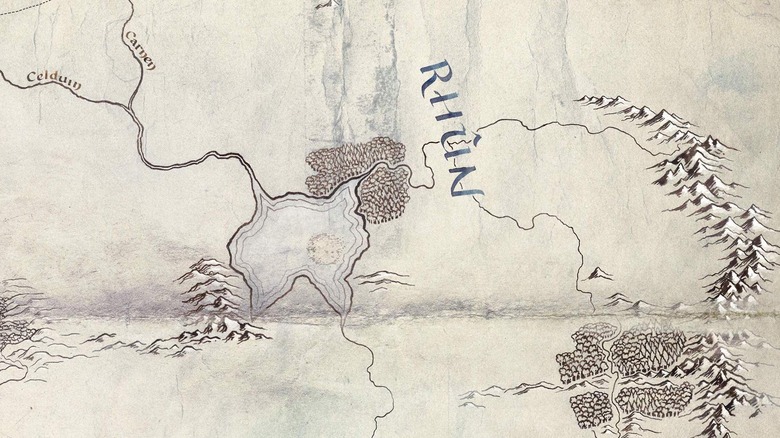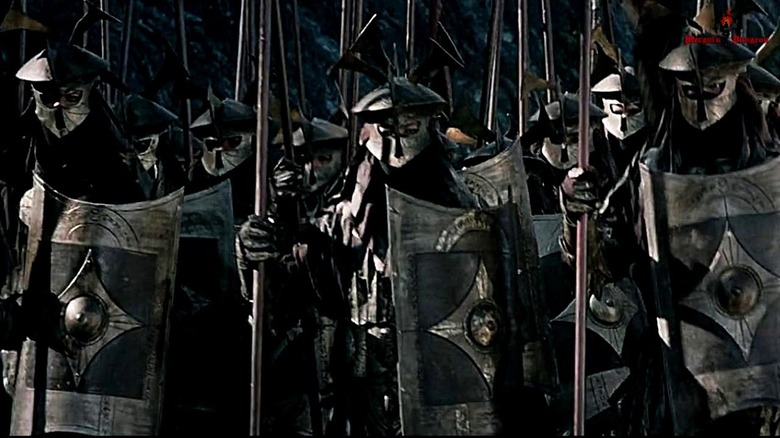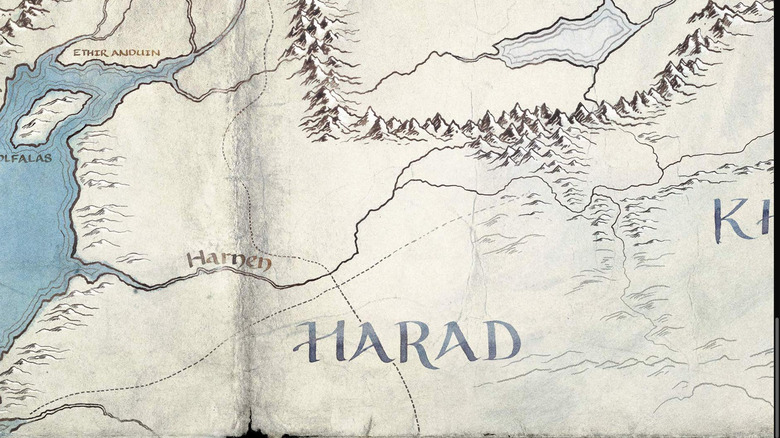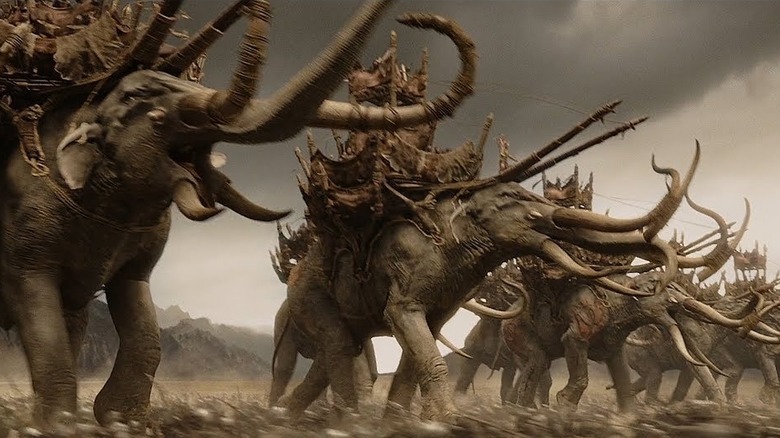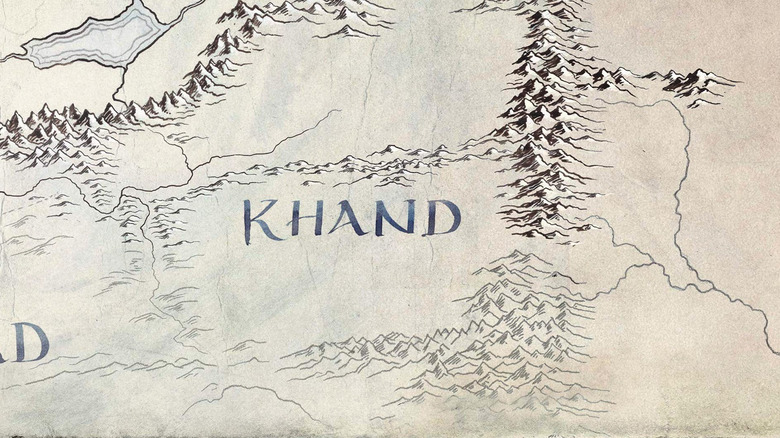The Lord Of The Rings: Explaining The Kingdoms Of Harad, Khand, And Rhun
J.R.R. Tolkien was very thorough in his world-building efforts — at least as far as the northwestern region of Middle-earth is concerned. Areas like Gondor, Rivendell, the Shire, and even the further west continent of the Blessed Realm all get a lot of attention in his writings.
However, there are other areas of the author's world that tended to get the scraps of his attention. The far eastern and southern reaches of Tolkien's maps tend to contain scattered names and lots of open spaces.
Nevertheless, Tolkien didn't completely neglect these far-flung areas of his creation. Three areas, in particular, get some exposition — if you're willing to dig for it, at least. We're talking about the kingdoms of Rhûn, Harad, and Khand.
Each of these areas impacts the "Lord of the Rings" story in its own way. For instance, Sauron has Easterlings from Rhûn and soldiers from Khand that fight in his armies. The black ships that Aragorn heads off on his way to the Battle of the Pelennor Fields are from Harad, too.
Apart from a handful of moments, we don't see much of these eastern and southern areas in the primary "LotR" and "Hobbit" stories. That said, we may get a bit more of these distant lands in Amazon's Middle-earth series. Why is that? Because the studio included extensive sections of them on the expansive maps they released on Twitter. It also created a synopsis that refers to going "to the furthest reaches of the map."
If that's true, we may be in for a bit more exploration in Amazon's upcoming project. Fortunately, there is a treasure trove of little factoids scattered throughout Tolkien's Middle-earth writings that can give us a better idea of what these countries look like. Let's take a look, shall we?
Rhûn is a hot spot early in Middle-earth history
If you head east on Tolkien's Middle-earth maps, you pretty quickly run into a giant, open area with a handful of names and the large Sea of Rhûn serving as the defining landmark of the region. This area is often collectively referred to as the "East" and its people as the "Easterlings." This eastern portion of Middle-earth is originally known for being a mysterious location. At the Council of Elrond in "The Fellowship of the Ring," Aragorn mentions that he's traveled "even into the far countries of Rhûn and Harad where the stars are strange."
In "The Silmarillion," we read that early in Middle-earth history, the area sees a large number of Elves and Men pass through. These people are mostly wandering from their earliest origins even farther away in the East across Rhûn and into the West.
In the deep-cut Tolkienian book "The Peoples of Middle-earth," Tolkien's son, Christopher, talks about notes and short descriptions that his father had written. Some of these describe how a portion of these nomads settles down near the Sea of Rhûn. Here their language diverges from their brethren and they become local inhabitants. "The Peoples of Middle-Earth" also mention that Dwarves likely lived in the surrounding areas, with four of the seven great houses of the Dwarves — the Ironfists, Stiffbeards, Blacklocks, and Stonefoots — building mansions in the East.
Apart from these basic facts, the history of the East is relatively quiet, as far as the source material goes. It isn't until later in the Second and Third Ages that things pick up speed, with the drama really starting when Sauron arrives on the scene. While Tolkien never goes into much detail, he repeatedly references the work of the Dark Lord as he subjugates the lands, bringing some of the Dwarves and most of the Men under his control.
Rhûn is Sauron's stomping ground for ages
One of the most well-known facts about the East is that it's the place where the enigmatic Blue Wizards visit when they arrive in Middle-earth. Unlike Saruman, Gandalf, and Radagast, the Blue Wizards spend their entire careers in the East.
In earlier writings, Tolkien claims that the pair of wanderers fail in their noble yet undefined objectives, much like Saruman. However, in his later writings, which are included in "The Peoples of Middle-earth," the two wizards are actually key players in resisting Sauron's dominion over Men in the eastern parts of Middle-earth. One of them is even called "East-helper," and the book states that their work weakens and confuses the forces of the East. In fact, without the wizards' activity, the Easterlings would have "outnumbered the West" during the War of the Ring.
Regardless of the success or failure of the Blue Wizards, the bulk of Rhûn's history revolves around one person: Sauron. The Dark Lord spends a lot of time in the East. There's even a point in the Third Age, about a thousand years before "The Hobbit" story, when Gandalf tries to discover Sauron, causing the unprepared villain to flee before he's caught. And where does the Dark Lord go? Why to his faithful servants in the East, of course, where he consolidates power amongst the tribes of Easterlings that he's cowed and forced to follow him.
Over the millennia of its existence, the Men of Rhûn also attack Gondor — more than once. The appendix for "The Return of the King" explains that two of Gondor's earlier kings are particularly known for fighting with the Easterlings quite a bit. One of them is killed in the action, but the other "won much territory eastwards."
Harad is a hot, wild land in the South
Harad refers to the extensive regions south of Gondor and Mordor. These are very mysterious, but appear to mirror the geographic feel of Africa in the real world. In "The Silmarillion," we hear about "the heats of the South" and regions are even mentioned that are "beyond the South to the Nether Darkness." In "The Two Towers," a reference is made to "apes in the dark forests of the South" and Sam talks to Gollum about "the Sunlands" of the South and the "oliphaunts" (read: giant elephants) that live there.
Like Rhûn, Harad sees a lot of migrations as Men, including Tolkien's famous wood people, the Drúedain, pass through the land heading West. The region appears to be populated early on, but we don't hear much about the Haradrim themselves until the Second Age. When they do pop up, Tolkien describes the people of Harad as "a great and cruel people that dwelt in the wide lands south of Mordor..." It's an image that matches up with the wild men seen riding oliphaunts in battle in Peter Jackson's trilogy.
During the Second Age, the Men of Númenor begin to explore the coast of Middle-earth, including the areas adjacent to Harad. Here, they meet the local inhabitants and begin interacting with them and teaching them craftsmanship and agriculture. However, over time they also start making settlements of their own, and before long they're the top dogs in the region.
The most important of these settlements is a haven for their ships called Umbar. In "The Silmarillion," this is referred to as a "mighty haven...that no hand had wrought." Apparently, it's a natural phenomenon that made for an excellent harbor. The area becomes a central part of Haradrim politics in the future.
Harad is caught in the crossfire
While the Númenóreans living along the coast of Harad are helpful at first, over time they begin demanding tribute. Sauron also sets up shop just to the north in Mordor and grows powerful during this era. Eventually, the two rivals start to duke it out with the natives of the land stuck in between.
Eventually, Sauron gains the upper hand, and, like Rhûn, Harad becomes little more than an extension of his realm. In "The Silmarillion," it explains that during this time "in the east and south well nigh all Men were under his dominion, and they grew strong in those days and built many towns and walls of stone, and they were numerous and fierce in war and armed with iron." It also adds that "to them, Sauron was both king and god; and they feared him exceedingly..."
By the end of the Second Age, Sauron is defeated for the first time (when the One Ring is cut from his hand.) The Númenóreans are also destroyed, but their realms of Gondor and Arnor survive. And it's at this point that the history of Harad comes to life.
Throughout the Third Age that follows, Gondor fights many wars with the Haradrim. At various times, both countries play the aggressor and see various victories and defeats. These wars are complicated, though, as the Gondorians fight both the people of Harad as well as a group of scoundrels called the Black Númenóreans. These are their relatives from Númenór who chose to follow Sauron. They serve as an elite "upper crust" of cruel aristocrats that often show up as servants of Sauron and leading armies of Haradrim. A civil war in Gondor also leads to a faction of Gondorians settling in the South and creating an area called Umbar. This is where the fleet of Black Ships in "The Return of the King" hails from.
Khand and the three realms after the War of the Ring
Of the three lands surrounding Tolkien's narrative, Khand is the least talked about. At one point in Gondor's earlier history, they are invaded by a group of Easterlings called the Wainriders. During the invasion, the nomadic army moves through the territory of Khand and the locals seem to join them in their attack.
Also, in "The Return of the King" we hear that a group of soldiers called "Variags from Khand" fight at the Battle of the Pelennor Fields. Apart from these two tidbits, though, there is very little out there regarding what this third strange land southeast of Mordor was like — other than the fact that it, too, appears to have been thoroughly subdued by Sauron for large chunks of its history.
After the War of the Ring, we get a little more information about how at least two of these three peripheral kingdoms get along — and it's a bit of a mixed bag, to be honest. In "The Return of the King," it explains that, after he becomes king, Aragorn "pardoned the Easterlings that had given themselves up, and sent them away free, and he made peace with the people of Harad."
Sounds good, right? It turns out that it's not all sunshine and roses after the Ring is destroyed. Our buddy Aragorn, who rules for over a century, eventually quarrels with his neighbors for unknown reasons in the years that follow. In fact, both he and Éomer go to war together, leading their armies "beyond the Sea of Rhûn" and to "the far fields of the South."
While there isn't much out there beyond these basic elements, there's no doubt that Rhûn, Khand, and Harad all represent rich, unexplored areas of Tolkien's mythology. If Amazon or any other studio decides to weave them into future Middle-earth storytelling, it could add a fascinatingly diverse new perspective to the Middle-earth that we all know and love so well.

